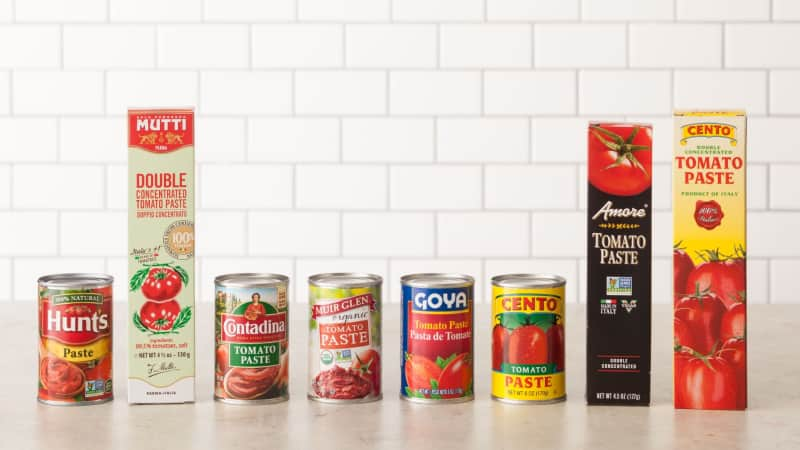Marinara Sauce
Recipe
American cans versus Italian tubes: We find out what's really important when it comes to buying this flavorful pantry staple.
Published Mar. 1, 2019. Appears in America's Test Kitchen TV Season 21: Indian Feast

Tomato paste is an inexpensive, versatile flavor powerhouse. We deploy its concentrated sweetness and savory umami flavor to bring depth and complexity to both classic applications (such as sauces, soups, and pastas) and unexpected ones (such as beef stew or spice-rubbed steak).
Historically, tomato paste has been sold in cans in the United States, but in the past decade, tubed pastes have popped up on supermarket shelves. Amore Tomato Paste was the first, but others have followed. When we studied the domestic tomato paste market, we found an intriguing pattern: Almost all the tubes are made in Italy, and all the cans are made in the United States. But considering that we often use such a small amount of paste in a recipe, does it even matter which product you buy?
We assembled a lineup of eight top-selling tomato pastes, priced from $0.12 to $0.78 per ounce: three Italian tubes and five American cans. We started by comparing everything about them: cost, packaging, ingredients, nutrition facts, and processing methods. Here's what we learned.
In general, the tubes cost about four times as much, averaging $0.67 per ounce compared to $0.16 per ounce for the cans (this excludes Muir Glen, which is organic and costs $0.57 per ounce). Experts told us that this is a matter of logistics—transporting the tubes from Italy costs money. You also get more paste in a can: All the cans in our lineup were 6 ounces, while all the tubes were about 4.5 ounces.
But the tubes are easier to use—just pop open the seal, use what you need, and put the tube back in the refrigerator. With the cans, you have to crank them open, portion out the desired amount, scrape the inevitable leftovers into another container, and store it in the refrigerator or freezer. (We suggest freezing tomato paste in small portions to make things easier.)
The tubes also last longer. Joseph Cristella IV, the chief operating officer at Cento Fine Foods, which manufactures both tubed and canned pastes, told us that tubed paste will last 30 to 45 days before the flavor starts to change, while a paste that's been transferred from a can to a sealed container will keep for only seven to 14 days. Our storage tests confirmed this.
All the pastes in our lineup are made with oblong Roma-style tomatoes, which the industry refers to as “processing” tomatoes. They're bred to have specific characteristics, such as being fleshier and firmer so they yield more solids and can handle being transported. They're designed to ripen at the same time, so a machine can pull the entire plant up by the roots, which are bred to release easily from the gr...
The mission of America’s Test Kitchen Reviews is to find the best equipment and ingredients for the home cook through rigorous, hands-on testing.

Hannah is an executive editor for ATK Reviews and cohost of Gear Heads on YouTube.

This is a members' feature.